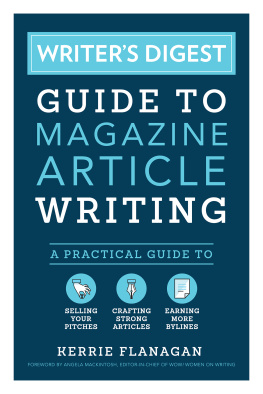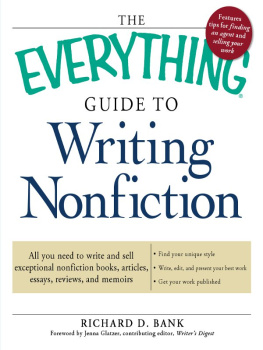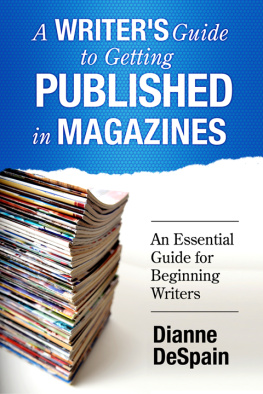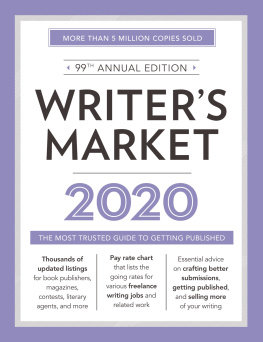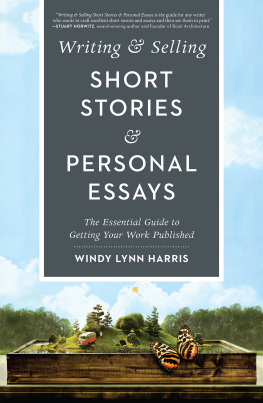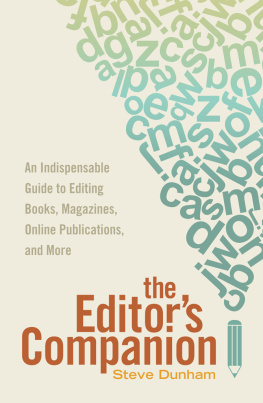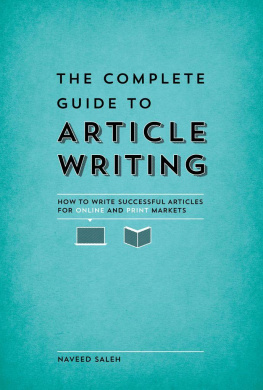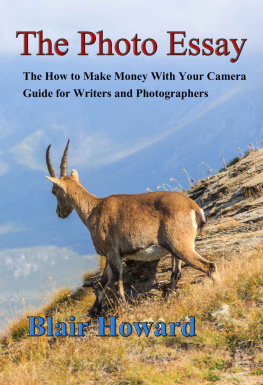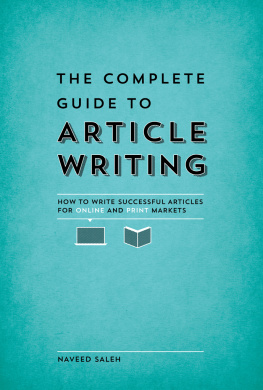Contents
Guide
WRITERS DIGEST GUIDE TO MAGAZINE ARTICLE WRITING
KERRIE FLANAGAN

WritersDigest. com
Cincinnati, Ohio
TABLE OF CONTENTS
CHAPTER ONE
Why Write for Magazines?
CHAPTER TWO
Whats the Big Idea?
CHAPTER THREE
Studying a Magazine
CHAPTER FOUR
Writing an Effective Query Letter
CHAPTER FIVE
Contracts & Rights
CHAPTER SIX
Writing the Article
CHAPTER SEVEN
Goal Setting
CHAPTER EIGHT
Productivity, Organization, and Creativity
CHAPTER NINE
How to Write and Sell Personal Essays
CHAPTER TEN
How to Write for Online Markets
CHAPTER ELEVEN
Use Magazine Writing to Build your Author Platform
DEDICATION
To writers, past, present, and future, whose inquisitive nature fills the pages of magazines with information, inspiration, and fascinating curiosities.
FOREWORD
In 2003, I wasnt an online magazine editor just yet. Id whittled my day job in advertising down to two days a week and was carving my path into full-time freelancing. My niche was in the action sports industry. It was by accident, really. My husband was the marketing director for a skateboard shoe company, and I tagged along to skateboarding competitions and trade shows. Being in the scene gave me ideas and introductions. I crafted pieces that were published in magazines, like Transworld Skateboarding, Thrasher, and Vice Magazine, as well as trade publications, like Footwear News. I wrote company newsletters and ad copy. I subcontracted photographers and videographers to create irresistible content packages and marketing materials. And within the first year of freelancing, I made more than $75,000, which was more money than Id ever made in a single year.
At the same time, I wrote fiction. I wanted to be the next Chuck Palahniuk, writing dark and twisty tales in media res with characters whod been marginalized by society and reacted with self-destructive aggressiveness. In fact, my style was so similar to his that several writers in an online writers forum wondered if I was him! I obviously hadnt cultivated my own voice yet, but I managed to get several short stories published in literary journals. I was thrilled. I wanted to immerse myself in the literary world of critique groups, contests, conferences, and workshops. I wanted to meet publishing industry professionals.
In September 2006, my business partner and I launched WOW! Women On Writingan online magazine for writers, authors, editors, agents, publishers, and readersbecause there was nothing like it at the time. Our mission was to give women writers a platform to share their professional knowledge with one another. Since then, WOW has evolved into a gender fluid space, grown exponentially and won awards, including the Writers Digest 101 Best Sites for Writers award for more than eight years. As executive editor, Ive personally worked with hundreds of talented writers. One of the most creative and professional freelancers Ive had the pleasure of working with is the author of this book, Kerrie Flanagan.
In 2009, Kerrie sent a letter of introduction that caught my attention. She talked about her passion for helping writers, her 100+ clips, and her experience starting the Northern Colorado Writers (NCW) organization. She wrote about an NCW conference, where she mingled with authors and agents and pitched article ideas for our various departments. Honestly, what impressed me about her letter was our shared vision of helping writers and her impressive knowledge of the industry, plus the names she mentioned didnt hurt. I wanted to get to know those agents, and I knew our readers did, too. That sparked an idea. I wrote her back immediately and asked her to write the article, How to Pitch an Agent at a Writers Conference for our Agents & Authors December 09 issue. I suggested she use tips from her NCW conference workshop and agent interviews in the article. She delivered exactly what I envisioned, and our relationship was sealed.
When an editor finds a freelancer who delivers polished articles on time and is a pleasure to work with, its magical. The formalities disappear, and its just a matter of putting your heads together and creating great content. Kerries strength is coming up with creative ideas that I never would have. Her vision inspires mine. Plus, shes a phenomenal writer, and her writing style is friendly and knowledgeable, as youll soon see in this book.
If you are a writer just starting out or have some clips, but want to land better assignments, this book is gold. As someone whos worked on both sides of the desk, I can tell you that Kerries advice will save you years of learning the hard way.
Take special note of the chapter on querying since this will be your very first impression with editors. I hate to sound like a grumpy gatekeeper, but in recent years Ive seen a lack of query etiquette. Out of every hundred query letters I read, maybe five are professional with ideas that target our e-zines content and audience. The rest are for subjects like yoga mats and feminism, or state: I want to write for you. How do I get paid? Flinging your work like wet pasta out into the publication world and hoping it sticks doesnt work.
If you follow the steps in this book, you will be successful. Ive never read a book this in-depth on the subject of writing articles for magazines. Kerrie shows you how to study a magazine (in an ingenious way I havent heard of before) and walks you through each step, providing worksheets to help you track a publications needs. She chats with amazing writers, like Andrew McCarthy who shares a kernel that will change the way you think about beginning an article. The editor round-ups are priceless. Editors from publications, like The Costco Connection and Cond Nast Traveler, share their best tips. It feels like youre sitting across from them having coffee.
And thats not all. Kerrie provides you with the tools to succeed as a freelancer, including practical tips on goal setting, productivity, and awakening your creative muse. Theres also a chapter on writing and selling personal essays that reads like a mini-book. The chapter on writing for online markets highlights the differences between print and online; and finally, there is a fascinating chapter on using article writing to build a platform. If you are a fiction writer, you will learn how to pull topics from your novel to craft articles that will help you find readers. And thats what we all ultimately want, right? To find readers. To build our tribe. To share our ideas with the world.
Theres an inspirational quote from Harry Potter author J.K. Rowling: Anythings possible if youve got enough nerve.
Writing and submitting certainly takes nerve, and the possibilities are endless, but courage is not enough. It also takes know-how. Thats what this book can provide. Mix in a dash of determination and a pinch of persistence, and youve got a winning recipe for freelancing success.
Follow the advice in this book and get your words published.
Write on!
Angela Mackintosh
Editor-in-Chief, WOW! Women On Writing
www.wow-womenonwriting.com
INTRODUCTION
I never wanted to be a writer. I am not one of those people who knew from childhood that this was the profession for me. Dont get me wrong; I liked writing and English classes throughout school. I even loved diagramming sentences, but I never fantasized about being the next C.S. Lewis or Laura Ingalls Wilder (two of my favorite authors growing up).

